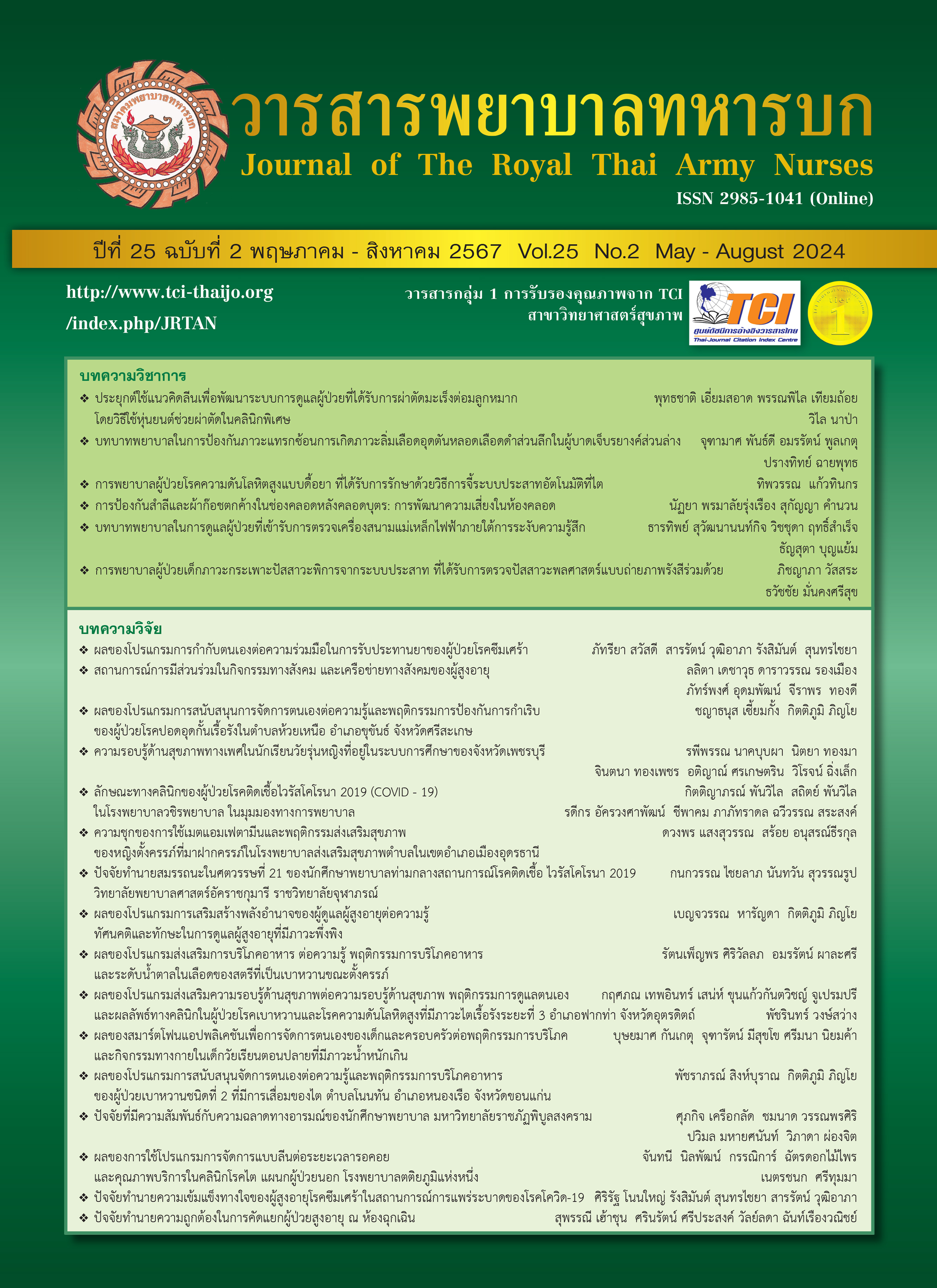Nurse’s Role in Preventing Deep Vein Thrombosis-related Complications in Patients with Lower Extremity Injury
Keywords:
Deep vein thrombosis, Venous thrombosis, Pulmonary embolism, Lower extremity InjuryAbstract
Deep vein thrombosis (DVT) is one of the most commonly found complications in patients with lower extremity injury. Over half of those involve DVT-related complications, and blood clot moves along with the blood flow, causing a blockage in the venous thrombosis, until it become blocked in the lung, It is pulmonary embolism (PE). It may occur at one location or many multiple locations. It is classified as a lift-threatening condition. This is because the blocked blood clot may escape through the bloodstream. In general, this group of patients can be prevented and treated. Nurses have a critical role to play in risk assessment and nursing to preventing DVT-related complications is a significant cause of morbidity and mortality in trauma patients. This article aims to summarize and synthesize the current evidence regarding DVT incidence, risk factors, diagnostic tools, and prophylactic methods, and to consolidate the evidence about DVT management. Evidence supporting nurses’ role in preventing DVT-related complications in patients with lower extremity injury were investigated as this could support the development of prevention strategies, appropriate nursing management, and DVT monitoring, especially in the acute phase post-injury, to reduce long-term disability, hospital mortality, and prolonged hospitalization.
Downloads
References
Bhatt M, Braun C, Patel P, Patel P, Begum H, Wiercioch W, et al. Diagnosis of deep vein thrombosis of the lower extremity: a systematic review and meta-analysis of test accuracy. Blood advances. 2020;4(7):1250-64.
Alshoabi A. & Mothanna A. Deep venous thrombosis: commonly affected veins in the lower limbs. Journal of Biosciences and Medicines. 2019;7:142-9.
Scolaro J, Taylor R, Wigner N. Venous thromboembolism in orthopaedic trauma. The Journal of the American Academy of Orthopaedic Surgeons. 2015;23(1):1-6.
Pongsriroj D, Waewwanjit D, Nimitpan P, Akaraborwoen O. Impact of implementation of clinical nursing practice guidelines in prevention of venous thromboembolism on multiple traumatic injury patients’ incidence of venous thromboembolism, length of hospitalisation, and medical expenses. Journal of Thailand Nursing and Midwifery Council. 2022;37(2):46-60. (in Thai)
Badash I, Pott E, Wu B. Venous thromboembolism in the setting of orthopedic trauma surgery. Clinical Trials in Orthopedic Disorders. 2016;1(4):128-37.
Bui H, Hung D, Vinh P, Hiep N, Anh L, Dinh T. Frequency and risk factor of lower-limb deep vein thrombosis after major orthopedic surgery in Vietnamese patients. Open Access Macedonian Journal of Medical Sciences. 2019;7(24):4250-4.
Sriprayoon W, Surakan E, Siriwanitchaphan W. Prevalence of venous thromboembolism in trauma patients in a private tertiary care hospital. The Bangkok Medical Journal. 2020; 16(1):13-5.(in Thai)
Hamada S, Espina C, Guedj T, Buaron R, Harrois A, Figueiredo S, et al. High level of venous thromboembolism in critically ill trauma patients despite early and well-driven thromboprophylaxis protocol. Annals of Intensive Care. 2017;7(1):97-110.
Pramnoi T, Danaidutsadeekul S, Chanruangvanich W. Factors predicting traumatic patients readiness for hospital discharge after extremity surgery. Journal of The Royal Thai Army Nurses. 2022;23(2):179-87. (in Thai)
Norasan S, Gajasen C, Soonthonkit Y, Jaihow R, Sripoom T, Singhatas P. Assessing the risk and incident of deep vein thrombosis in icu trauma patients, Ramathibodi hospital using caprini score. Journal of Nursing Division. 2020;47(2): 20-31. (in Thai)
Mohamed A, Othman W, Alphy B, Sheble A. Effect of implementing nursing care guidelines on the occurrence of deep vein thrombosis among orthopedic patients. Journal of Nursing and Health Science. 2017;6(3):28-36.
Barp M, Carneiro V, Amaral K, Pagotto V, Malaquias S. Nursing care in the prevention of venous thromboembolism: an integrative review. Revista Eletronica de Enfermagem. 2018; 20(14):1-13.
Tan L, Qi B, Yu T, Wang C. Incidence and risk factors for venous thromboembolism following surgical treatment of fractures below the hip: a meta-analysis. International wound journal. 2016;13(6):1359-71.
Horner D, Pandor A, Goodacre S, Clowes M, Hunt B. Individual risk factors predictive of venous thromboembolism in patients with temporary lower limb immobilization due to injury: a systematic review. Journal of thrombosis and haemostasis. 2019;17(1): 329-44.
Maeseneer M, Bochanen N, Rooijen G, Neglen P. Analysis of 1,338 patients with acute lower limb deep venous thrombosis (DVT) supports the inadequacy of the term “proximal DVT”. European journal of vascular and endovascular surgery : the official journal of the European Society for Vascular Surgery. 2016;1(51):415-20.
Herdman H, Kamitsuru S. Nursing diagnoses definitions and classification. 11st, editor. Wiley blackwell, 2020.
Saket R, Aggarwal S, Kumar V, Kumar P, Patel S. Acute venous thromboembolism in Indian patients of isolated proximal femur fractures. Journal of clinical orthopaedics and trauma. 2019;10(5):917-21.
Wang P, Li J, Fei C, Li Z, Ke C, Shang K, et al. Deep vein thrombosis in the uninjured limb in patients with lower extremity fractures: a retrospective study. BioMed research international. 2020:1-7.
Nielsen S, Connor D, Kaul S, Sharma J, Napolitano M, Simonian G, et al. Early detection of deep venous thrombosis in trauma patients. Cureus.2020;12(7):1-8.
Min S, Kim Y, Joh J, Kang J, Park U, Kim H, et al. Diagnosis and treatment of lower extremity deep vein thrombosis: Korean practice guidelines. Vascular specialist international. 2016;32(3):77-104.
Siriraj concurrent trigger tool by MEWs in elective surgery adult hospitalized patient DVT of lower extremity guideline. 2023.
Chang W, Wang B, Li Q, Zhang Y, Xie W. Study on the risk factors of preoperative deep vein thrombosis (DVT) in patients with lower extremity fracture. Clinical and applied thrombosis/hemostasis : official journal of the International Academy of Clinical and Applied Thrombosis/Hemostasis. 2021;27(1):1-6.
Downloads
Published
How to Cite
Issue
Section
License
Copyright (c) 2024 Journal of The Royal Thai Army Nurses

This work is licensed under a Creative Commons Attribution-NonCommercial-NoDerivatives 4.0 International License.
บทความหรือข้อคิดเห็นใดใดที่ปรากฏในวารสารพยาบาลทหารบกเป็นวรรณกรรมของผู้เขียน ซึ่งบรรณาธิการหรือสมาคมพยาบาลทหารบก ไม่จำเป็นต้องเห็นด้วย
บทความที่ได้รับการตีพิมพ์เป็นลิขสิทธิ์ของวารสารพยาบาลทหารบก
The ideas and opinions expressed in the Journal of The Royal Thai Army Nurses are those of the authors and not necessarily those
of the editor or Royal Thai Army Nurses Association.






